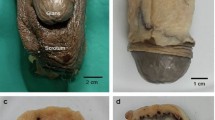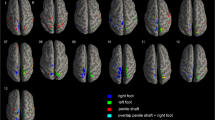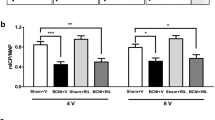Abstract
Penile erection is a complex neurovascular event. The neuronal system involved is often divided into a spinal (generator) and supraspinal (controller) network. Little is known about the supraspinal control. The recent finding of changes in penile erection following deep brain stimulation of the thalamus in two patients has raised the question as to what extent the thalamus is involved in erectile function. The thalamus has generally been regarded as a group of relay nuclei that served as a ‘gate’ for sexual information from the spinal cord towards higher centres. Recent evidence, however, suggests a more integrated regulatory function. Our review of the literature from 1960 until 2003 revealed 13 reports describing original data (preclinical and clinical). Various thalamic regions, varying from the midline thalamus to the posterior thalamus, have been reported to be activated during erection. The majority of the reports, however, showed that mainly the mediodorsal (MD) nucleus and the centromedian–parafascicular nucleus (Cm–Pf complex) are involved in penile erection. MD is the second largest nuclear aggregation located within the medial part of the thalamus. Anatomically, the MD is closely related to the Cm–Pf complex. The Cm–Pf complex is one of the most important relay stations in which the anterolateral spinothalamic pathway is further processed. This pathway is thought to transmit peripheral sexual sensations. On the whole, the present data on the role of the thalamus in erection are far from complete and future experiments are required to delineate its involvement.
This is a preview of subscription content, access via your institution
Access options
Subscribe to this journal
Receive 8 print issues and online access
$259.00 per year
only $32.38 per issue
Buy this article
- Purchase on Springer Link
- Instant access to full article PDF
Prices may be subject to local taxes which are calculated during checkout


Similar content being viewed by others
References
Lue TF . Erectile dysfunction. N Engl J Med 2000; 342: 1802–1813.
Steers WD . Neural pathways and central sites involved in penile erection: neuroanatomy and clinical implications. Neurosci Biobehav Rev 2000; 24: 507–516.
Rosen RC, Sachs BD . Central mechanisms in the control of penile erection: current theory and research. Neurosci Biobehav Rev 2000; 24: 503–505.
Giuliano F, Rampin O . Central neural regulation of penile erection. Neurosci Biobehav Rev 2000; 24: 517–533.
McKenna KE . Some proposals regarding the organization of the central nervous system control of penile erection. Neurosci Biobehav Rev 2000; 24: 535–540.
Rampin O, Giuliano F . Brain control of penile erection. World J Urol 2001; 19: 1–8.
Kuthe A . Phosphodiesterase 5 inhibitors in male sexual dysfunction. Curr Opin Urol 2003; 13: 405–410.
McKenna KE . Central control of penile erection. Int J Impot Res 1998; 10(Suppl 1): S25–S34.
Beach FA . Sexual attractivity, proceptivity, and receptivity in female mammals. Horm Behav 1976; 7: 105–138.
Argiolas A . Oxytocin stimulation of penile erection. Pharmacology, site, and mechanism of action. Ann NY Acad Sci 1992; 652: 194–203.
Park K et al. A new potential of blood oxygenation level dependent (BOLD) functional MRI for evaluating cerebral centers of penile erection. Int J Impot Res 2001; 13: 73–81.
Montorsi F . Tolerability and safety of apomorphine SL (Ixense (TM)). Int J Impot Res 2003; 15(Suppl 2): S7–S9.
Montorsi F et al. Pharmacological management of erectile dysfunction. BJU Int 2003; 91: 446–454.
Hsieh GC et al. Central mechanisms regulating penile erection in conscious rats: the dopaminergic systems related to the proerectile effect of apomorphine. J Pharmacol Exp Ther 2004; 308: 330–338.
Temel Y et al. Deep brain stimulation of the thalamus can influence penile erection. Int J Impot Res 2004; 16: 91–94.
MacLean PD, Ploog DW . Cerebral presentation of penile erection. J Neurophysiol 1962; 25: 29–55.
MacLean PD, Denniston RH, Dua S . Further studies on cerebral representation of penile erection: caudal thalamus, midbrain, and pons. J Neurophysiol 1963; 26: 273–293.
Robinson BW, Mishkin M . Penile erection evoked from forebrain structures in Macaca mulatta. Arch Neurol 1968; 19: 184–198.
Sapolsky RM, Eichenbaum H . Thalamocortical mechanisms in odor-guided behavior. II. Effects of lesions of the mediodorsal thalamic nucleus and frontal cortex on odor preferences and sexual behavior in the hamster. Brain Behav Evol 1980; 17: 276–290.
Karama S et al. Areas of brain activation in males and females during viewing of erotic film excerpts. Hum Brain Mapp 2002; 16: 1–13.
Montorsi F et al. Brain activation patterns during video sexual stimulation following the administration of apomorphine: results of a placebo-controlled study. Eur Urol 2003; 43: 405–411.
Arnow BA et al. Brain activation and sexual arousal in healthy, heterosexual males. Brain 2002; 125: 1014–1023.
Vandewalle V, van der Linden C, Groenewegen HJ, Caemaert J . Stereotactic treatment of Gilles de la Tourette syndrome by high frequency stimulation of thalamus. Lancet 1999; 353: 724.
Visser-Vandewalle V et al. Chronic bilateral thalamic stimulation: a new therapeutic approach in intractable Tourette syndrome. J Neurosurg 2003; 99: 1094–1100.
Pfaus JG et al. Sexual stimulation activates c-fos within estrogen-concentrating regions of the female rat forebrain. Brain Res 1993; 624: 253–267.
Temel Y, Helmy A, Pinnock S, Herbert J . Effect of serotonin depletion on the neuronal, endocrine and behavioural responses to corticotropin-releasing factor in the rat. Neurosci Lett 2003; 338: 139–142.
Heeb MM, Yahr P . c-Fos immunoreactivity in the sexually dimorphic area of the hypothalamus and related brain regions of male gerbils after exposure to sex-related stimuli or performance of specific sexual behaviors. Neuroscience 1996; 72: 1049–1071.
Veening JG, Coolen LM . Neural activation following sexual behavior in the male and female rat brain. Behav Brain Res 1998; 92: 181–193.
Coolen LM, Peters HJ, Veening JG . Distribution of Fos immunoreactivity following mating versus anogenital investigation in the male rat brain. Neuroscience 1997; 77: 1151–1161.
Ohkura S, Fabre-Nys C, Broad KD, Kendrick KM . Sex hormones enhance the impact of male sensory cues on both primary and association cortical components of visual and olfactory processing pathways as well as in limbic and hypothalamic regions in female sheep. Neuroscience 1997; 80: 285–297.
Heeb MM, Yahr P . Anatomical and functional connections among cell groups in the gerbil brain that are activated with ejaculation. J Comp Neurol 2001; 439: 248–258.
Coolen LM, Veening JG, Petersen DW, Shipley MT . Parvocellular subparafascicular thalamic nucleus in the rat: anatomical and functional compartmentalization. J Comp Neurol 2003; 463: 117–131.
Coolen LM, Veening JG, Wells AB, Shipley MT . Afferent connections of the parvocellular subparafascicular thalamic nucleus in the rat: evidence for functional subdivisions. J Comp Neurol 2003; 463: 132–156.
Ohye C . Thalamus. In: Paxinos G (ed). The Human Nervous System. Academic Press. Inc.: San Diego, 1990, pp 439–482.
Kandel ER . The neurobiology of behavior. In: Kandel ER, Schwartz JH, Jessel TM (eds). Principles of Neural Science. McGraw-Hill: New York, 2000, pp 1–36.
Guyton AC, Hall JE . Somatic Sensations: the tactile and position senses. In: Guyton AC, Hall JE (eds). Textbook of Medical Physiology. WB Saunders: Philadelphia, 1996, pp 595–607.
Armstrong E . Limbic thalamus: anterior and mediodorsal nuclei. In: Paxinos G (ed) The Human Nervous System. Academic Press, Inc.: San Diego, 1990, pp 469–481.
Acknowledgements
This study was funded by the Dutch Medical Research Council (NWO/Zon MW), Grant 940-37-027 and the Dutch Brain Foundation (Hersenstichting) Grants 10F02.13, 10F03.19 and 10F04.17.
Author information
Authors and Affiliations
Corresponding author
Rights and permissions
About this article
Cite this article
Temel, Y., Visser-Vandewalle, V., Ackermans, L. et al. Thalamus and penile erection. Int J Impot Res 16, 505–511 (2004). https://doi.org/10.1038/sj.ijir.3901233
Received:
Revised:
Accepted:
Published:
Issue Date:
DOI: https://doi.org/10.1038/sj.ijir.3901233
Keywords
This article is cited by
-
Neuroimaging and Sexual Behavior: Identification of Regional and Functional Differences
Current Psychiatry Reports (2015)



